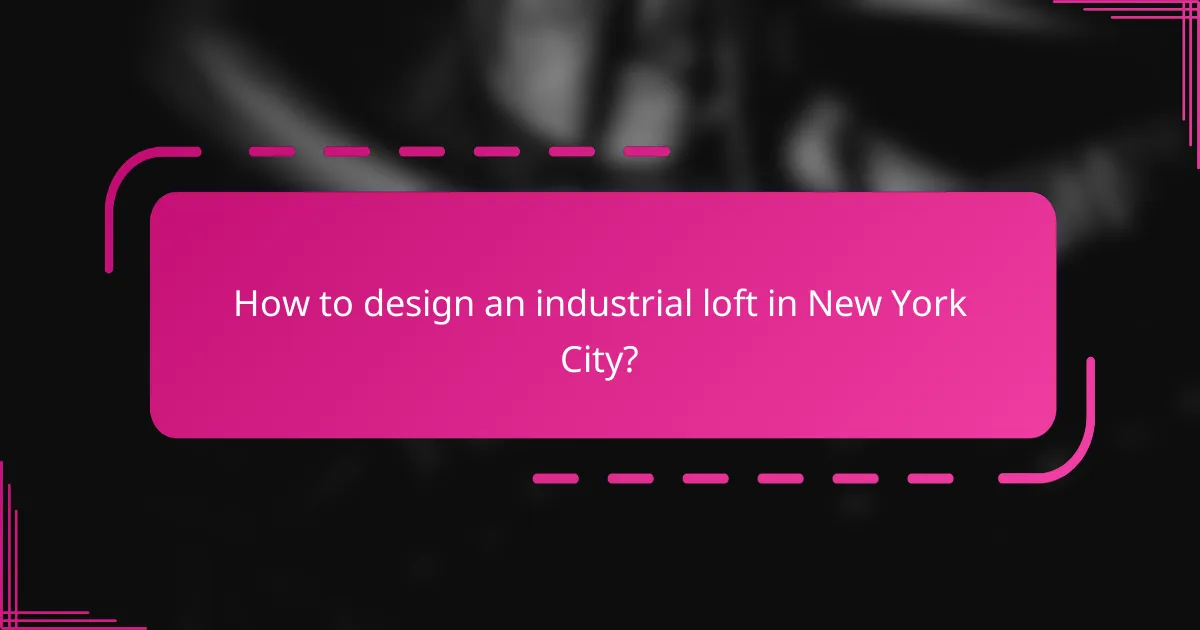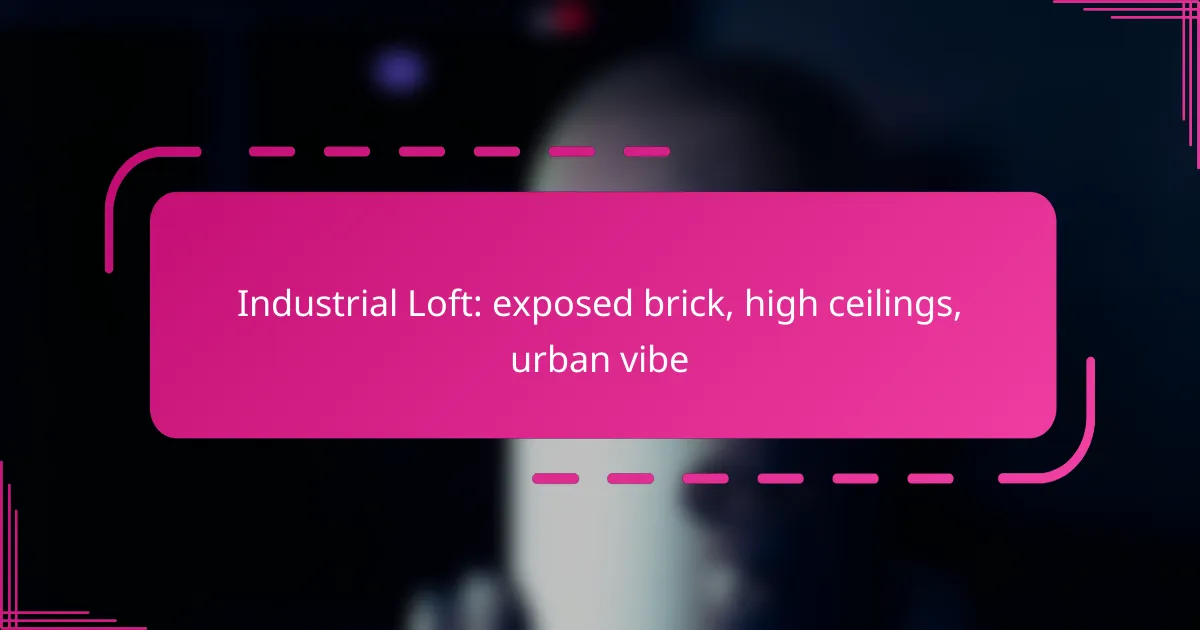Industrial lofts embody a distinctive blend of raw materials and modern design, creating an inviting urban atmosphere. With features like exposed brick walls and soaring high ceilings, these spaces offer a unique living experience that emphasizes openness and creativity. The combination of industrial charm and contemporary aesthetics makes loft living a vibrant choice for those seeking a dynamic lifestyle.

How to design an industrial loft in New York City?
Designing an industrial loft in New York City involves blending raw materials with modern aesthetics to create a unique urban living space. Focus on elements like exposed brick, high ceilings, and urban-inspired decor to capture the essence of loft living.
Incorporate exposed brick walls
Exposed brick walls are a hallmark of industrial lofts, adding character and warmth to the space. When selecting a brick wall, consider leaving it in its natural state or applying a clear sealant to enhance its texture while preserving its rustic appeal.
To maintain a cohesive look, pair exposed brick with neutral color palettes for furniture and decor. This contrast will highlight the brick’s texture and create a balanced atmosphere.
Utilize high ceilings for open spaces
High ceilings are essential in industrial lofts, providing an airy and spacious feel. Aim for ceilings that are at least 10 feet high to maximize the sense of openness and allow for creative design elements like hanging light fixtures or artwork.
Consider using vertical space effectively by incorporating tall bookshelves or artwork that draws the eye upward. This not only enhances the loft’s height but also adds visual interest to the overall design.
Choose urban-inspired decor
Urban-inspired decor complements the industrial aesthetic by incorporating modern, minimalist designs and materials. Look for furniture made from metal, wood, or leather to maintain a cohesive industrial look.
Accessorize with bold artwork, geometric patterns, and industrial lighting fixtures to enhance the urban vibe. Mixing vintage and contemporary pieces can also add depth and personality to the space.

What are the key features of industrial lofts?
Industrial lofts are characterized by their unique architectural elements that create an urban and spacious atmosphere. Key features include exposed brick walls, high ceilings, and an open floor plan that emphasizes a raw, unfinished aesthetic.
Exposed structural elements
Exposed structural elements are a hallmark of industrial lofts, showcasing beams, columns, and ductwork that contribute to the space’s character. These features not only add visual interest but also highlight the building’s industrial origins.
When designing with exposed elements, consider the balance between functionality and aesthetics. Leaving structural components visible can enhance the loft’s appeal but may require additional maintenance to keep them looking their best.
Large windows for natural light
Large windows are essential in industrial lofts, allowing ample natural light to flood the space. This feature not only brightens the interior but also connects the inhabitants with the urban environment outside.
When selecting windows, opt for styles that complement the industrial vibe, such as steel-framed or factory-style windows. Ensure that they meet local building codes for energy efficiency to maintain comfort and reduce utility costs.
Raw materials like metal and wood
Raw materials, including metal and wood, play a significant role in defining the industrial loft aesthetic. These materials can be used in furniture, fixtures, and finishes, creating a cohesive look that emphasizes authenticity.
Incorporate reclaimed wood for flooring or furniture to add warmth and character. Pair it with metal accents, such as steel shelving or light fixtures, to maintain the industrial feel while ensuring durability and style.

What are the benefits of living in an industrial loft?
Living in an industrial loft offers a unique blend of style, space, and urban energy. These residences typically feature exposed brick, high ceilings, and an open layout that fosters creativity and a vibrant lifestyle.
Unique aesthetic appeal
The industrial loft style is characterized by its raw, unfinished look, which includes elements like exposed beams and ductwork. This design creates a visually striking environment that stands out from traditional homes, making it a popular choice for those who appreciate modern art and architecture.
Many lofts also incorporate large windows that allow natural light to flood the space, enhancing the overall aesthetic. This combination of features creates a distinctive atmosphere that can be both inviting and inspiring.
Spacious living areas
Industrial lofts typically boast open floor plans, which provide ample space for living, working, and entertaining. High ceilings often create a sense of grandeur, making the area feel even more expansive.
This layout allows for flexible use of the space, enabling residents to customize their living environment according to their needs. Whether you prefer a minimalist approach or a more eclectic decor, the spaciousness of a loft can accommodate various styles.
Vibrant urban lifestyle
Living in an industrial loft often places you in the heart of a bustling urban environment. This proximity to city amenities, such as restaurants, galleries, and parks, enhances the overall lifestyle experience.
Residents typically enjoy easy access to public transportation and cultural events, fostering a sense of community and engagement. The urban vibe of loft living encourages an active lifestyle, where social interactions and creative pursuits are part of daily life.

How to choose the right location for an industrial loft?
Choosing the right location for an industrial loft involves considering accessibility, neighborhood characteristics, and market trends. A well-situated loft can enhance your living experience and investment potential.
Consider proximity to amenities
When selecting a location for an industrial loft, proximity to essential amenities is crucial. Look for nearby grocery stores, restaurants, parks, and public transportation options. Being within walking distance to these conveniences can significantly improve your quality of life.
For example, a loft located within a 10-15 minute walk from a subway station or bus stop can save you time and enhance your daily commute. Consider the availability of local services, such as gyms or cafes, that align with your lifestyle.
Evaluate neighborhood vibe
The vibe of the neighborhood plays a significant role in your overall satisfaction with an industrial loft. Spend time exploring the area at different times of the day to get a feel for the atmosphere. Look for signs of community engagement, such as local events or art installations.
Consider whether the neighborhood aligns with your personal style and interests. An urban area with a vibrant arts scene may appeal to some, while others might prefer a quieter, more residential setting. Safety and cleanliness are also important factors to assess.
Research local real estate trends
Understanding local real estate trends is essential for making an informed decision about your loft’s location. Investigate property values, rental rates, and market demand in the area. This information can help you gauge whether the investment is likely to appreciate over time.
Look for neighborhoods experiencing revitalization or growth, as these areas often present better investment opportunities. Online real estate platforms and local market reports can provide valuable insights into current trends and forecasts.

What are the costs associated with industrial lofts in Chicago?
The costs associated with industrial lofts in Chicago can vary significantly based on location, size, and condition. Buyers should expect to consider not only the purchase price but also renovation expenses, property taxes, and insurance premiums.
Average price per square foot
The average price per square foot for industrial lofts in Chicago typically ranges from the mid-200s to the low 400s in USD. Factors influencing this price include the loft’s location within the city, its amenities, and the overall market demand. In popular neighborhoods like the West Loop or River North, prices may trend higher due to desirability.
Renovation costs for authenticity
Renovation costs for maintaining the authentic industrial look of a loft can vary widely, often ranging from tens of thousands to over a hundred thousand USD. Key expenses may include restoring exposed brick, updating plumbing and electrical systems, and installing high ceilings. Homeowners should budget for both cosmetic updates and structural improvements to ensure safety and livability.
Property taxes and insurance
Property taxes for industrial lofts in Chicago can be significant, often falling between 1.5% to 2.5% of the property’s assessed value annually. Insurance costs will also depend on the loft’s location and condition, typically ranging from a few hundred to several thousand USD per year. It’s advisable to consult with local real estate experts to get accurate estimates based on specific properties.

What are the best furniture options for industrial lofts?
The best furniture options for industrial lofts typically feature materials and designs that complement the space’s exposed brick, high ceilings, and urban vibe. Look for pieces that combine functionality with a rugged aesthetic, often incorporating metal, wood, and leather.
Vintage industrial furniture
Vintage industrial furniture is a popular choice for industrial lofts, as it enhances the raw, urban feel of the space. Items like metal stools, reclaimed wood tables, and factory carts can serve as both functional pieces and conversation starters.
When selecting vintage industrial furniture, consider the condition and authenticity of the pieces. Look for items that show signs of wear, which can add character, but ensure they are still sturdy and safe for everyday use.
Mixing vintage pieces with modern elements can create a balanced look. For example, pairing a weathered metal dining table with sleek, contemporary chairs can highlight the loft’s unique style while maintaining comfort and usability.
